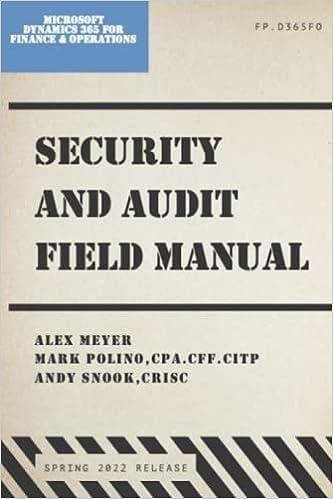Question
SAGE 50 ACCOUNTING I Choose the best answer for the following questions: (20 Points) 1. A recurring entry is an entry that: Occurs regularly. Occurs
SAGE 50 ACCOUNTING
I Choose the best answer for the following questions: (20 Points)
1. A recurring entry is an entry that:
- Occurs regularly.
- Occurs seldom.
- Is to be deleted on a regular basis.
- Will occur only within the next two months.
2. Which of the following items do not need a negative amount to record the amount?
- Recording a sale to a customer with HST.
- Return of merchandise from a customer.
- Write-off of a customer bad debt balance.
- Reduction in the selling price of an invoice (previously recorded).
3. If theHST Paid on Purchases account balance is more than the HST Charged on Sales balance:
- You have made an error and will need to check previous purchases.
- You must wait until the HST Charged on Sales account balance is more that the HST on Purchases before you can issue a cheque.
- You will receive a cheque for the difference after you submit the HST report.
- You must enter the difference as a purchase and record a cheque.
4. In reference to Account Codes, which of the following statements is not correct:
a) H - Headings are not postable and have no balances. They are descriptions only.
b) A - Accumulate column accounts are postable. Debits and Credits from the general journal can be posted to these and their balances are added together to show a sub-total.
c) S - Subtotals are postable. A accounts are always followed by an S account.
d) G - Group column accounts are postable. Debits and Credits from the general journal can be posted to these.
e) T - Total accounts are not postable. They end each section and have no balances. They are descriptions only.
5. In the EMPLOYEES & PAYROLL module, payroll entries recorded with errors:
- Can be corrected using the Calculate Taxes Automatically" icon.
- Are reversed using a negative amount in the "Payroll Cheque Run."
- Are reversed using the Adjust Payroll icon, selecting the cheque in error and reversing the cheque
- Are corrected using positive amounts in the "Payroll Cheque Run."
6. Inventory adjustments are required when:
- Goods are accidentally broken by staff.
- The cost price of goods purchased decreases.
- The selling price of goods increases or decreases.
- Items are purchased that were not in inventory before.
7. In Inventory, the Build from Bill of Materials Journal is used when:
- You need to reduce the number of items you have in stock.
- You need to increase the number of items you have in stock.
- You are returning goods that are damaged.
- You need to put together a package of different products that customers want to buy at a reduced price.
8. Which of the following is not true? Adjusting entries:
- Are done to ensure the revenue recognition and matching principles are met.
- Are usually done during the review of the companys accounts at month-end.
- Can conveniently be set up as recurring entries to be modified and processed on a monthly basis.
- Are completed on a random basis, depending on the manager of the business.
9. In Sage 50 Accounting when the session date is advanced to the first day of the next fiscal year, which of the following entries need to be reversed.
- Estimated bank statement charges, Depreciation of capital assets, salary accrual.
b. Depreciation of capital assets, salary accrual (weekly payroll) and office supplies.
c. Estimated bank statement charges, salary accrual (bi-weekly payroll), and prepaid supplies.
d. Estimated bank statement charges, salary accrual (bi-weekly payroll) and interest accrued (due monthly on the 15th of each month).
10. In the PROJECTS Module, which of the following is not true for the Allocation of costs:
- by a set amount.
- on an amount based on a percentage.
- by employee hours.
- by budget dollars.
II Answer by saying Tue or False to the following questions (10 Points)
- When you post a journal entry in Sage 50 Accounting, all modules are immediately updated except the general ledger.
- The employer portion of E.I. and CPP is deducted from the employee and remitted to the Receiver General each month
- Prepayments to vendors are held as debits in the vendor account.
- Conversion means changing from a manual system to a computerized one or changing from one computerized system to another.
- Debits on the bank statement increase the bank balance.
III Answer the following Questions Briefly (20 points)
- There is a journal called Build from Bill of Material in Inventory & Services Module. What is the use of it? describe briefly.
- Explain the difference between perpetual inventory system and periodic inventory system briefly.
- There are three ways of correcting an entry in SAGE 50 Mention and explain them. Make a single journey.
- The payroll data may be entered into SAGE 50 Accounting in two different ways. What are these two journals and how do we use them?
- What does it mean by NSF and what journal is used to record it in SAGE 50 accounting?
Step by Step Solution
There are 3 Steps involved in it
Step: 1

Get Instant Access to Expert-Tailored Solutions
See step-by-step solutions with expert insights and AI powered tools for academic success
Step: 2

Step: 3

Ace Your Homework with AI
Get the answers you need in no time with our AI-driven, step-by-step assistance
Get Started


